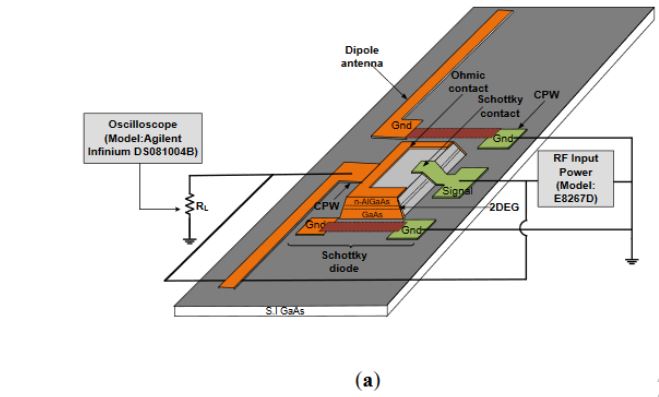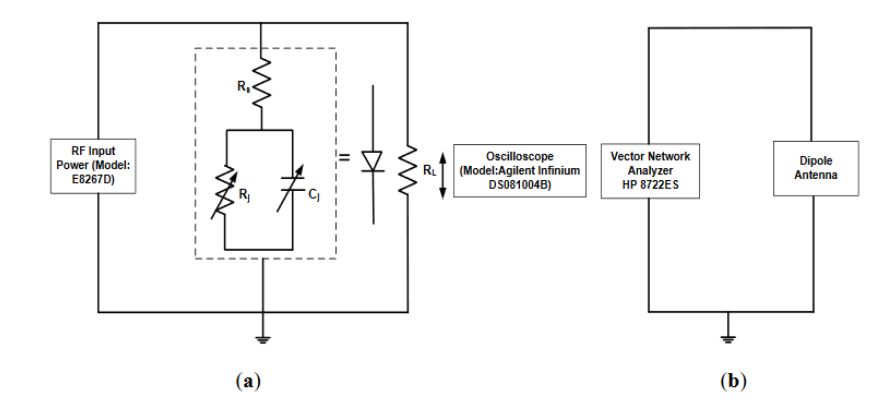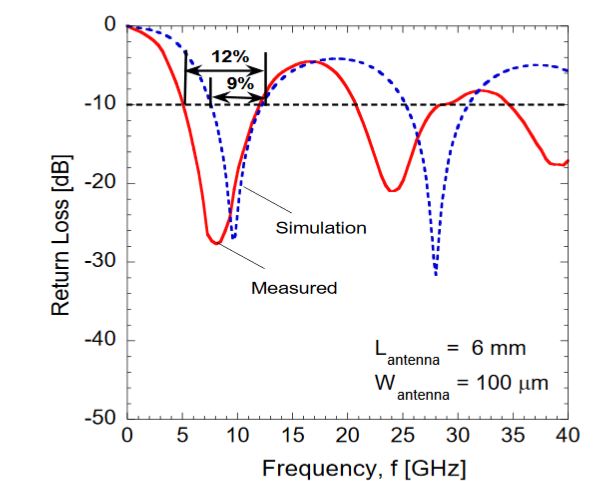ABSTRACT
We report the RF-to-DC characteristics of the integrated AlGaAs/GaAs Schottky diode and antenna under the direct injection and irradiation condition. The conversion efficiency up to 80 % under direct injection of 1 GHz signal to the diode was achieved. It was found that the reduction of series resistance and parallel connection of diode and load tend to lead to the improvement of RF-to-DC conversion efficiency.
Under direct irradiation from antenna-to-antenna method, the output voltage of 35 mV was still obtainable for the distance of 8 cm between both antennas in spite of large mismatch in the resonant frequency between the diode and the connected antenna. Higher output voltage in volt range is expected to be achievable for the well-matching condition. The proposed on-chip AlGaAs/GaAs HEMT Schottky diode and antenna seems to be a promising candidate to be used for application in proximity communication system as a wireless low power source as well as a highly sensitive RF detector.
FABRICATION OF THE INTEGRATED DEVICE

Figure 1. (a) Schematic and (b) top view photo of the rectenna device
Co-integration of various kinds of functional devices including rectenna devices on the same core material structure is more practical in terms of fabrication processes and cost. Thus, the development of rectenna devices based on such a structure has been considered in this study. In this work, we fabricated the CPW and dipole antenna structure on the semi-insulated (SI) GaAs layer, and not directly on the n-type HEMT structure, as shown in Figure 1a. The HEMT structures was etched to the SI layer during the process of mesa formation by using a mixture of sulphuric acid.
RESULT AND DISCUSSION

Figure 2 . The circuit configuration for : (a) the Schottky diode and (b) the dipole antenna in direct injection experiment
The output voltage increases with the increase of injected voltage. From this measurement, the turn on voltage, the operating frequencies and the RF characteristics of the diode were evaluated. Next, an HP8722ES Network Analyzer (VNA) equipped with the same microprober, as shown in Figure 2b, was used to measure and confirm the resonant frequency of the dipole antenna.

Figure 6. Measured and simulated return loss of the dipole antenna
Figure 6 shows the return loss characteristics as a function of frequency for the fabricated antenna. The dipole antennas have also been designed and simulated using the commercial Electromagnetic Sonnet Suites simulator. As shown in Figure 6, there was almost 3% difference of frequency bandwidth at −10 dB between the measured and simulated response for the first resonant harmonic.
CONCLUSIONS
In conclusion, the rectification by the integrated Schottky diode and dipole antenna via CPW transmission line under direct irradiation from antenna-to-antenna was achieved without insertion of any matching circuit. Higher output voltages, up to the volt range, are expected to be achievable if the resonant frequency of the dipole antenna is well matched to the optimum operating frequency of the diode that produces the maximum rectified output.
Despite of the large mismatch in the frequency between the diode and antenna, output voltages of several tens of mV were still obtainable for a distance of 8 cm. This seems to suggest the feasibility of using such integrated device structures in proximity communication systems.
Source: University Technology Malaysia
Authors: Farahiyah Mustafa | Abdul Manaf Hashim
>> 60+ Antenna Communication Projects for Engineering Students
>> 60+ Project Report on Microstrip Patch Antenna for Final Year Students